Metallic Threads
Metallic Threads
Metallic Threads add much to a hand-embroidered project. The beauty lies in the reflection of light off the metallic threads which makes them shimmer and shine. For that reason, metallic threads have been highly prized in Ecclesiastical Embroidery for centuries.
There is a wide variety of metallic threads available today for use in Ecclesiastical Embroidery. So it is time to step out of your comfort zone and give a few of these beautiful colored metallic embroidery threads a try.

Passing Threads
Recently, I shared a post on these Passing Threads and the need for wrapping them on a thread spool. The metallic finish on these passing threads is delicate and they take some care when stitching. It is always a good idea to be careful and avoid nicking metallic threads with a sharp needle as they are couched in place.
The red, green, and blue threads are a bit more forgiving as they have colored cores that match the metallic finish. But the copper passing thread has a light yellow core as can be seen in the photo. If the thread is bent too far, the metallic finish breaks easily, or if the needle nicks it, the yellow core shows readily. Any twists or kinks in the copper passing thread break the metallic finish and show the core. Sounds rather ominous to stitch with! But that also creates the challenge with hand embroidery. Knowing that certain threads have limitations, one tries to figure out ways to overcome and work around those issues.
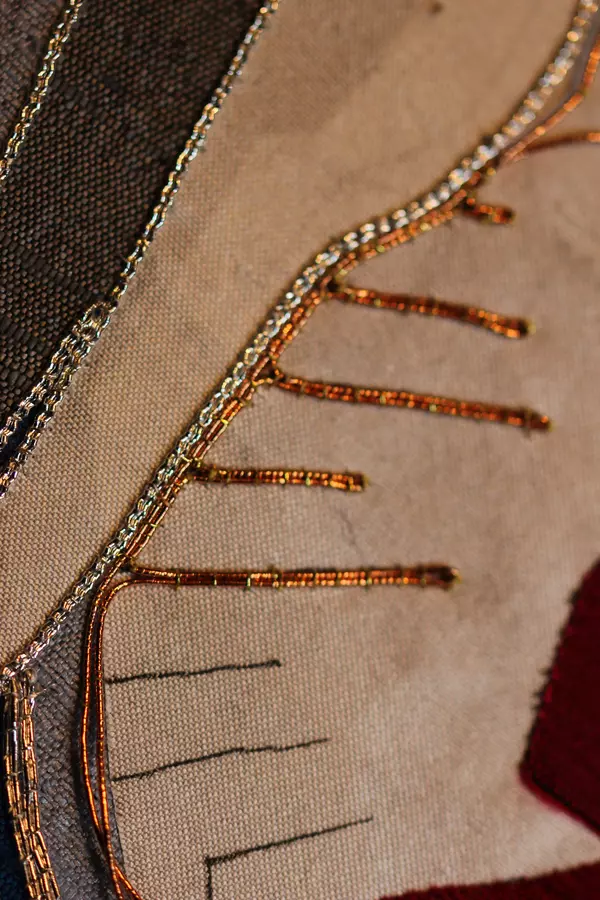
Copper Passing Thread
This rich copper thread was selected for use on the Advent Pulpit Fall as the color for the Shell. And while this thread is working, some stitching issues are presenting a few challenges. The copper thread needs to bend back on itself and has many sharp angles and turns. One could have done all those short pieces and plunged both ends, but who wants to do all of that plunging?
Normally with a metallic thread, it can be over-twisted to prevent the core from showing. But that little trick does not work on this passing thread. If it is handled too roughly, the metallic finish breaks, and the core shows. For future reference, it will help to note that the Copper passing thread works well couched in straight rows, with no bends or turns. The delight and reason for sticking it out with this thread is the color. The warm copper color adds a wonderful contrast to the silver and other metallic colors.
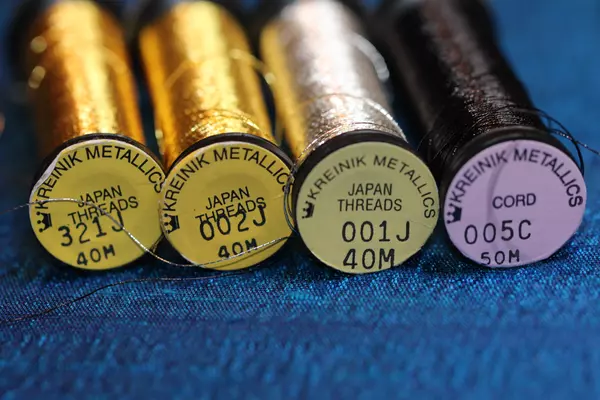
Kreinik Japan Threads
Depending on what is read across the web, sometimes Kreinik Japan Threads get a bad wrap out there. The gold and silver Japan Threads by Kreinik in size 1 are great for couching metal threads – but perhaps – not for the beginner. These threads are very fine which makes them both a joy and a struggle to work with. The joy is that once they are stitched over a metallic thread, they become almost invisible. The frustration is that they can knot and tangle easily if one is not careful. Most of the time, couching threads are run through beeswax to strengthen them.
The Japan Threads in size 1 are the exception. No beeswax is needed here. To minimize the risk of tangles and knots on the back side of your work, keep the thread lengths shorter than normal. Try to pull the thread straight up as it comes from the backside. Check the back with your fingers and give a little gentle extra tug to be sure the thread has pulled completely through without leaving a loop on the backside. With a little practice, one can easily get the hang of using these threads.
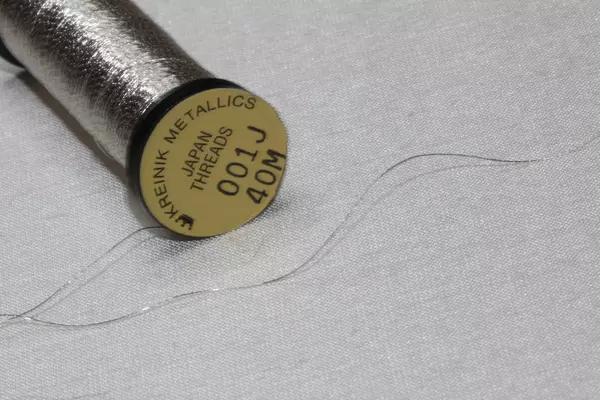
Kreinik Japan Threads in Various Sizes
Using the Japan Thread in size 1 to couch the Silver Check thread results in an almost invisible stitch. It is easy to see why. The thread is very fine. Yet it is also strong enough to handle the couching. The shine blends with the shine of the threads being couched.
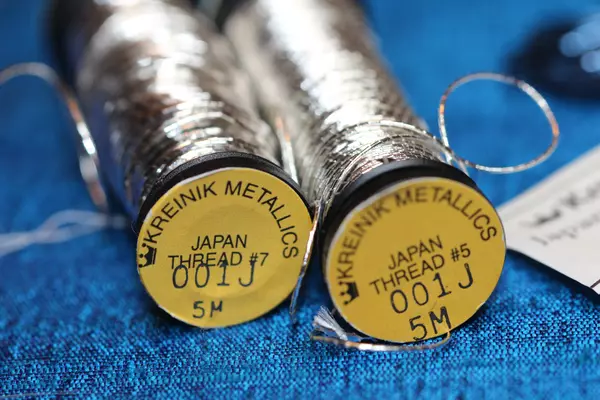
Kreinik also makes the Japan Thread in size 5 and size 7. These are not “great” threads, but there is a purpose for them. They are not expensive, as compared to many metallic threads. They can be a little challenging at first to work with, as they “wriggle” a bit and have a bit of spring to them. Perhaps, again, not for the beginner. But these threads do have advantages and characteristics that make them appropriate for some stitching situations.
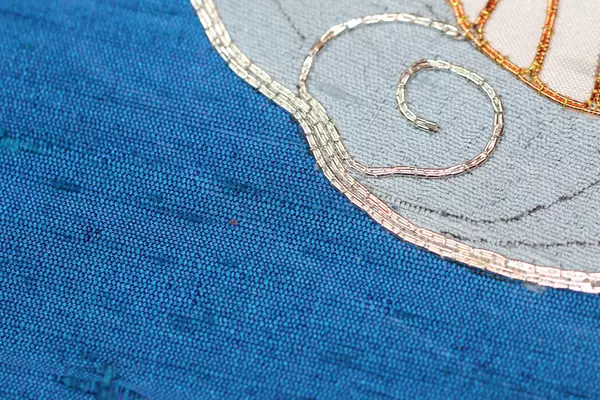
The Value of Kreinik Japan Threads in Metallic Embroidery
Shiny! That is what I love about the Kreinik Japan Threads. They have a shine that is difficult to match with any other metallic thread, and that shine can add much-needed contrast to some designs. Flexible! These tiny threads are very flexible. They manipulate curves easily. They are not very expensive, so they might be a good test thread for ideas, rather than using a more expensive metallic thread. With a little care and experience, these Japanese threads work fine for certain projects. One needs to handle the plunging of thread tails with delicate care so as not to unravel the metallic finish. Kreinik Japan Threads are not meant to take the place of the beautiful silver-plated threads, but they can still serve a purpose.
The hour is late, and there are still a few more metallic threads to touch on, but that will wait for another evening.
How about you – do you have a metallic embroidery thread that is a friend or a foe? Share your thread tales.
Solo Dei Gloria
Be sure to visit our online store front Ecclesiastical Sewing where you may shop for Liturgical Fabrics, altar linen fabrics, church vestment-making patterns, liturgical machine embroidery designs, church vestment trims and notions and so much more. You may also find us on Ecclesiastical Sewing on Facebook, Twitter, and Pinterest. Sign up for our mailing list at the bottom of the page on our online store front and receive a free copy of our Small Linens Booklet as our way of saying thank you for following along.
Advent Star Stitching Underway
Outlining: Finishing Touch or Distraction






 RSS - Posts
RSS - Posts
Very informative, Carrie. My one and only attempt at or nue was using Kreinik Japan 7 thread, using a single strand, couched with a single strand of silk– a small bird with a plain silver couched background. Things went well until I had to lay dense areas of color over the bird with the silver no. 7. When I reached the other side of the bird, there was no more pattern and all space for only couching, so after ten or so rows, the design began to bulge upwards and eventually I put it aside until my knowledge increases. Glad to see this post– every little bit increases my understanding.
Hi Jennifer,
Or Nue is a tricky thing, but it can be so lovely when complete. I have tried small bits and pieces of Or Nue, and it is fun. There are not many books with instruction out there on the technique, but the best instructions that I have found are Jane Zimmerman’s. http://ecclesiasticalsewing.wordpress.com/2014/10/16/ihs-turning-corners/ There are a few Gold (and Silver) threads out there that might make Or Nue easier. I will try to share some of those soon.